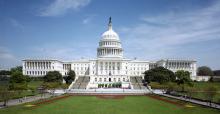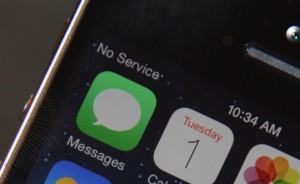
Fast, affordable Internet access for all.

September 21st is the last day individuals and organizations have to submit initial comments on the FCC’s “Inquiry Concerning Deployment of Advanced Telecommunications Capability to All Americans in a Reasonable and Timely Fashion,” Docket 17-199. As of this writing, more than 1,400 filers have submitted comments but the gravity of the policies the FCC is reviewing should have more input from all over the country. So far, people and organizations that have commented are not happy with the ideas of dumbing down the definition of "broadband" and letting mobile and satellite Internet access satisfy connectivity needs in rural America. What do you think? Let the FCC know.
Time and Speeds
The FCC released the Notice of Inquiry (NOI) on August 7th, asking for comments from the public on a broad range of issues. Many experts and organizations quickly zeroed in on a few topics that many thought would never become matters that would ever need to be argued again. Due to the magnitude of the issues to be decided, 13 organizations that work on telecommunications and digital divide policy requested that the agency extend the comment period, originally set for September 7th. Thirty days was just not enough time to address the numerous issues in the NOI.
 The agency proposed reversing a policy established by the Obama administration’s FCC which raised the definition of “broadband” to 25 Megabits per second (Mbps) download and 3 Mbps upload. The 2015 change better reflected our forward direction in technology. Chairman Ajit Pai’s leadership has questioned that move and is considering reversing course to a 10 Mbps download/1 Mbps upload definition, which reflects speeds more in line with DSL connections. The 10/1 benchmark is already considered obsolete by policy experts who see DSL connections already overly stressed by multi-device households.
The agency proposed reversing a policy established by the Obama administration’s FCC which raised the definition of “broadband” to 25 Megabits per second (Mbps) download and 3 Mbps upload. The 2015 change better reflected our forward direction in technology. Chairman Ajit Pai’s leadership has questioned that move and is considering reversing course to a 10 Mbps download/1 Mbps upload definition, which reflects speeds more in line with DSL connections. The 10/1 benchmark is already considered obsolete by policy experts who see DSL connections already overly stressed by multi-device households.
Many commenters express disdain with the idea of accepting slower speeds as “broadband,” especially those who live and work in rural areas. Mark Tatum from West Kill, New York, wrote about his company’s options:
To lower the standards that define broadband would immediately and directly affect our ability to function effectively and efficiently as a business that depends on the Internet. As a graphics intensive business that is involved with the day to day transfer of large amounts of data (I.e. graphics files etc.) that average 25 Mbps and more, the only viable way to conduct our type of B2B commerce is via high speed connectivity. Especially in the rural area where we are located. The alternative would be to go backwards to the pre WWW analog business model. To compete with a lower standard and definition of broadband would be an impossibility and would force marketing/design firms like ours to close shop. This cannot be defined as a step forward in a world that is ever more dependent on the WWW. Please consider the consequences for those outside of the well served metropolitan areas of our country before making any wholesale changes to the definition of what constitutes Broadband.
Others describe the idea of lowering speeds “absurd,” “disastrous for rural, poor, and underserved communities,” and asks the FCC, “Please don't make 'broadband' a sham term by lowering the definition.”
The State of Colorado’s Broadband Office opposes lowering the benchmark and suggests that the FCC clearly require 25 Mbps/3 Mbps as a minimum speed. They base their statement on the fact that subscribers often reach the threshold “only occasionally or during non-peak times.” Colorado’s SBO suggests the FCC tighten the requirements for what measurements qualify as 25 Mbps/3 Mbps connections, suggesting only connections that maintain that capacity 80 percent of the time or during peak traffic hours be considered broadband.
Is 25 Mbps/3 Mbps too slow? The National Electrical Manufacturers Association (NEMA) thinks it is and suggests the FCC raise the definition of “fixed broadband” to 100 Mbps/50 Mbps for all Americans. We applaud their suggestion that upload speeds be raised to at least half the speed of download to emphasize that subscribers are economic participants, not only consumers.
 Mobile and Satellite?
Mobile and Satellite?
Two of the most concerning proposals in the NOI are the possibility that mobile and satellite Internet access will be deemed acceptable forms of Internet access. In addition to the obvious problem of interference caused by weather and structures, filers complain of data caps that drive up the cost of poor Internet access.
Like other filers, NEMA considers mobile broadband a complement, not a substitute, and suggests separate benchmarks for each form of connectivity. They call attention to the fact that fixed and mobile connections serve different purposes:
For example, many connected home technologies use fixed residential connections to control home comfort, monitor smoke and carbon monoxide levels, and even higher bandwidth uses like streaming video. Other products, especially smart grid products, rely on mobile network access to relay information to utilities about the status of the electric grid and can help restore power quickly after an outage. Hospitals require high-bandwidth fixed connections to process medical images with large file sizes. The FCC should not allow access to either fixed or mobile broadband be a substitute for access to both fixed and mobile broadband.” [emphasis theirs]
A letter from a dozen United States Senators, including Al Franken, Elizabeth Warren, and Tom Udall described the lawmakers’ concern with the potential of stepping backward in rural America with this approach:
The FCC’s current policy provides that Americans need access to both mobile and fixed broadband services, with speeds of at least 25 Mbps download/3 Mbps upload. While we recognize and welcome the possibility that technology may one day evolve to a point where mobile broadband options could be deemed equivalent to fixed broadband services, that is not the case today. At this time, such a striking change in policy would significantly and disproportionately disadvantage Americans in rural, tribal, and low income communities across the nation, whose livelihoods depend on a reliable and affordable broadband connection.
…
In reading this notice of inquiry, it appears that the FCC, by declaring mobile service of 10 Mbps download/1 Mbps upload speeds sufficient, could conclude that Americans' broadband needs are being met—when in fact they are not. By redefining what it means to have access, the FCC could abandon further efforts to connect Americans, as under this definition, its statutory requirement would be fulfilled.
The lawmakers go on to point out that, in addition to broadening the digital divide, such a policy would prove disastrous for business owners who set up shop in regions beyond urban centers.
Officials in the community of Leverett, Massachusetts, felt compelled to share their experiences with poor connectivity prior to and after investing in their publicly owned infrastructure. In Leverett, upload capacity was a critical component of high-quality connectivity:
In our experience, the emphasis on "originate and receive" has special importance for businesses—home-based and telecommuting—that work with large data, graphics, and video transmissions. Mobile access—especially as subject to throttling of download speed, limited upload speed, and data caps—cannot provide sufficient Internet access to sustain information entrepreneurs.
Locals depended on slow DSL and satellite Internet access before they decided the community needed something better. In their comments, officials write how their Fiber-to-the-Home (FTTH) network, LeverettNet, has improved the local economy; new businesses have cropped up, including home-based businesses, and existing establishments have grown. Their real estate market has turned around and locals are saving money with better services.
Consider the Schuettes, who live outside of the city and work from home; they shared their experiences with the FCC:
We live in rural Minnesota, in the county of Douglas, just outside a city with a population of over 13,000. We are located just a few miles from town. The only option we have for Internet is cell phone or satellite dish. If there is a cloud in the sky, our reception is either completely gone or slowed dramatically. I have a home-based business (two of them) that requires reliable Internet. There are times I cannot conduct business because weather conditions won't allow, or data caps are reached. I have contacted local companies that offer broadband, and none of them have any inclination to come our direction.
 The Schuttes raise another issue - if we allow mobile and satellite to be considered "good enough" when it isn't, entities that wish to pursue funding for infrastructure to improve local connectivity will lose opportunities. As our readers know, many grants and loans are only available for unserved and underserved areas. Because the FCC's form 477 data uses the census block method of reporting, mapping typically overstates which areas have broadband connectivity; the problem will increase under the proposed benchmarks. With less financial incentives to invest in areas like the Schuttes's, residents and businesses face reduced prospects of better Internet access. The FCC also asks for comments on data collection as part of this NOI.
The Schuttes raise another issue - if we allow mobile and satellite to be considered "good enough" when it isn't, entities that wish to pursue funding for infrastructure to improve local connectivity will lose opportunities. As our readers know, many grants and loans are only available for unserved and underserved areas. Because the FCC's form 477 data uses the census block method of reporting, mapping typically overstates which areas have broadband connectivity; the problem will increase under the proposed benchmarks. With less financial incentives to invest in areas like the Schuttes's, residents and businesses face reduced prospects of better Internet access. The FCC also asks for comments on data collection as part of this NOI.
Listen to Christopher and Hannah talk about the issue of satellite and mobile connectivity in a recent Community Broadband Bits podcast. They get into why changing this policy will take us backwards and what is at risk.
The Easy Way Out Is Not The Answer
Certainly, the FCC sees the challenge of deploying advanced telecommunications capability to all Americans as formidable. Nevertheless, changing the parameters to lower the goal will further harm communities of color, lower-income, rural, or those who must otherwise contend with substandard connectivity. Individuals and organizations that have taken a few moments to comment on the NOI so far have overwhelmingly expressed their disfavor with the ideas of lowering the bar for connectivity in America through policy changes.
The policy changes in the NOI contradict the current administration’s mantra, as pointed out by Brandon Slywka, who took time from his vacation in Mexico to file a comment:
I am currently posting this from a resort while on vacation in Mexico and the internet is faster, more reliable and is broadband (fiber connection) than my internet connection in Upstate NY which is satellite because cable modem, FTTH is NOT an option. This is just completely unacceptable. [I live] just 2.5 hours from NYC and my only option for internet is satellite which means the ping/latency is over 600ms on a good day and 1000ms+ plus on a bad day. I cannot work remotely with this and many people do not come to the area and purchase real estate for a second home/vacation home because of this. The town is literally dying because they cannot provide it's residents and prospective residents with reliable and fast internet which is absolutely required to succeeded in today's technology enabled world. I believe in putting "America first" and this also means with technology….[M]obile broadband and satellite is just NOT a realistic and viable solution.
It Just Takes A Minute

What are your thoughts on these proposed changes? If you live in a rural area, or if you are forced to rely on satellite or mobile Internet access regardless of where you live, we encourage you to submit comments. Share your experiences and your thoughts as you consider the future of connectivity in the U.S. Are we deploying advanced telecommunications capability to all Americans in a reasonable and timely fashion? The FCC wants to hear from you.
Read the full NOI here and submit your comments here. Reply comments will be due on October 5th.
Photo of No Service courtesy of David Becher, via Pixaby.
